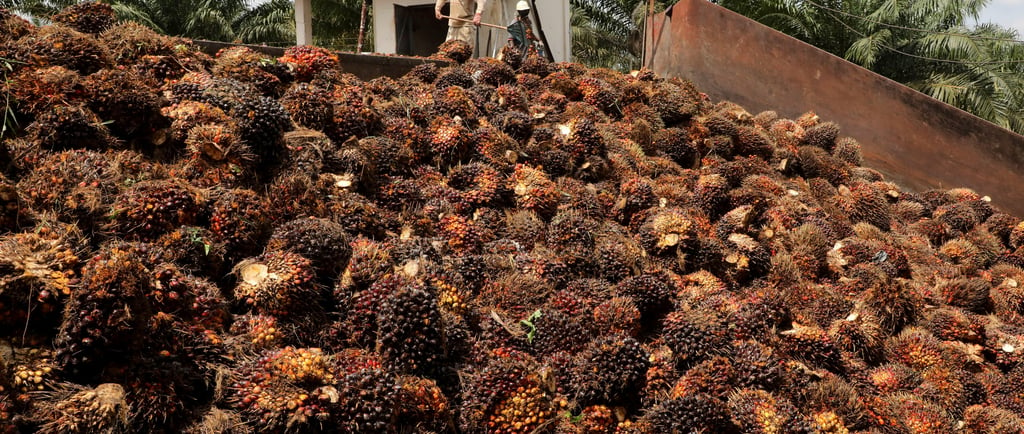Indonesia and Malaysia: Palm Oil and the Dilemma between Economic Growth and Environmental Costs
Palm oil is a crucial global commodity, found in a wide range of products from food to cosmetics, and supports the economies of countries like Indonesia and Malaysia. However, with growing concerns over deforestation, biodiversity loss, and climate change, can the industry strike a balance between economic growth and environmental sustainability?
INDONESIAMALAYSIA
Raymond Puentes
9/15/20243 min read


Palm oil, a versatile and highly productive crop, plays a pivotal role in global supply chains, underpinning industries from food production to cosmetics and biofuels. Over half of all packaged products worldwide, from ice cream to lipstick, contain palm oil, making it an essential commodity, particularly in developing countries. However, its vast importance to the global market comes with a steep environmental price, drawing growing scrutiny from environmentalists and consumers alike.
The palm oil tree thrives only in tropical regions, where it yields more oil at a lower cost compared to other vegetable oils. This efficiency has driven a surge in demand, leading to widespread plantation expansions across Asia, Africa, and Latin America. Indonesia and Malaysia dominate global production, together accounting for over 85% of the world's supply. For these nations, the economic rewards are significant, often overshadowing the environmental destruction tied to the industry's expansion, particularly the decimation of tropical rainforests home to endangered species.
Indonesia, the world's largest palm oil producer, generates more than 50 million tonnes of palm oil annually, with vast plantations stretching across Sumatra and Kalimantan. Favourable climatic conditions, government policies, and foreign investments have cemented Indonesia’s position as the industry leader. Malaysia, while producing less, still benefits greatly from the sector, yielding around 20 million tonnes each year in regions such as Peninsular Malaysia, Sabah, and Sarawak.
Yet, the rapid growth of palm oil plantations, especially in Southeast Asia, has come at a severe environmental cost. Deforestation is one of the industry's most damaging effects. Vast tracts of ancient rainforests are cleared to make way for palm oil cultivation, releasing enormous quantities of greenhouse gases and eroding the forests’ capacity to absorb carbon. The damage is even greater when plantations are established on peatlands, which release vast amounts of carbon dioxide when drained for agriculture.
Another consequence of palm oil expansion is the frequent and devastating forest fires, particularly in Indonesia, where the practice of slash-and-burn land clearing is common. These fires not only destroy large forested areas but also produce thick smog that blankets much of Southeast Asia, with serious environmental and public health implications. The fires are exacerbated by drained peatlands, which are highly flammable and contribute to the fires’ intensity. In turn, the loss of soil organic carbon from these areas further degrades the land, reducing its long-term agricultural productivity.
Water pollution also poses a significant challenge. Palm oil mills produce vast quantities of waste, known as palm oil mill effluent (POME), which can contaminate freshwater systems if not properly treated. For every tonne of palm oil produced, about 2.75 tonnes of waste are generated, threatening local ecosystems and communities. In Malaysia, untreated POME is a major concern for rivers and streams, though waste management solutions remain underused.
Despite the environmental fallout, Indonesia and Malaysia depend heavily on palm oil for economic growth, though their approaches to managing the industry diverge. Malaysia has adopted policies to preserve at least 50% of its forest cover, focusing on improving productivity on existing plantations rather than expanding into new areas. In contrast, Indonesia continues to prioritise expansion, placing less emphasis on sustainability, a strategy that has deepened the environmental and economic disparities between the two countries.
The palm oil industry thus presents a complex dilemma. On one hand, it provides vital income for nations like Indonesia and Malaysia, lifting millions out of poverty. On the other hand, it is a major contributor to deforestation, biodiversity loss, and climate change. Finding a balance between economic growth and environmental sustainability remains crucial for the industry's future. Governments and businesses alike must work together to adopt sustainable agricultural practices, improve waste management, and reduce palm oil’s environmental footprint.
As global demand for palm oil increases, the industry’s impacts extend far beyond Southeast Asia. International businesses, particularly those involved in food, cosmetics, and biofuels, are increasingly held accountable by consumers, investors, and regulators for their sourcing practices. The environmental and social issues tied to palm oil production risk damaging the reputation of companies that fail to implement responsible sourcing practices.
In response, multinational corporations have begun adopting sustainability measures, including certification programs such as the Roundtable on Sustainable Palm Oil (RSPO), which aims to ensure that palm oil is produced with minimal environmental harm and respects the rights of workers and indigenous communities. For these large companies, certification helps protect their brand image and avoid backlash from environmentally conscious consumers. However, smaller businesses often face significant challenges in meeting these standards. Many struggle to adapt their supply chains or bear the costs of sustainable practices, making it difficult for them to compete in the market.
Ultimately, the future of palm oil production will depend on striking a balance between economic interests and environmental responsibilities. Governments and businesses must play a crucial role in driving sustainability, ensuring that palm oil production evolves to meet the demands of a rapidly changing world while protecting the planet for future generations.


